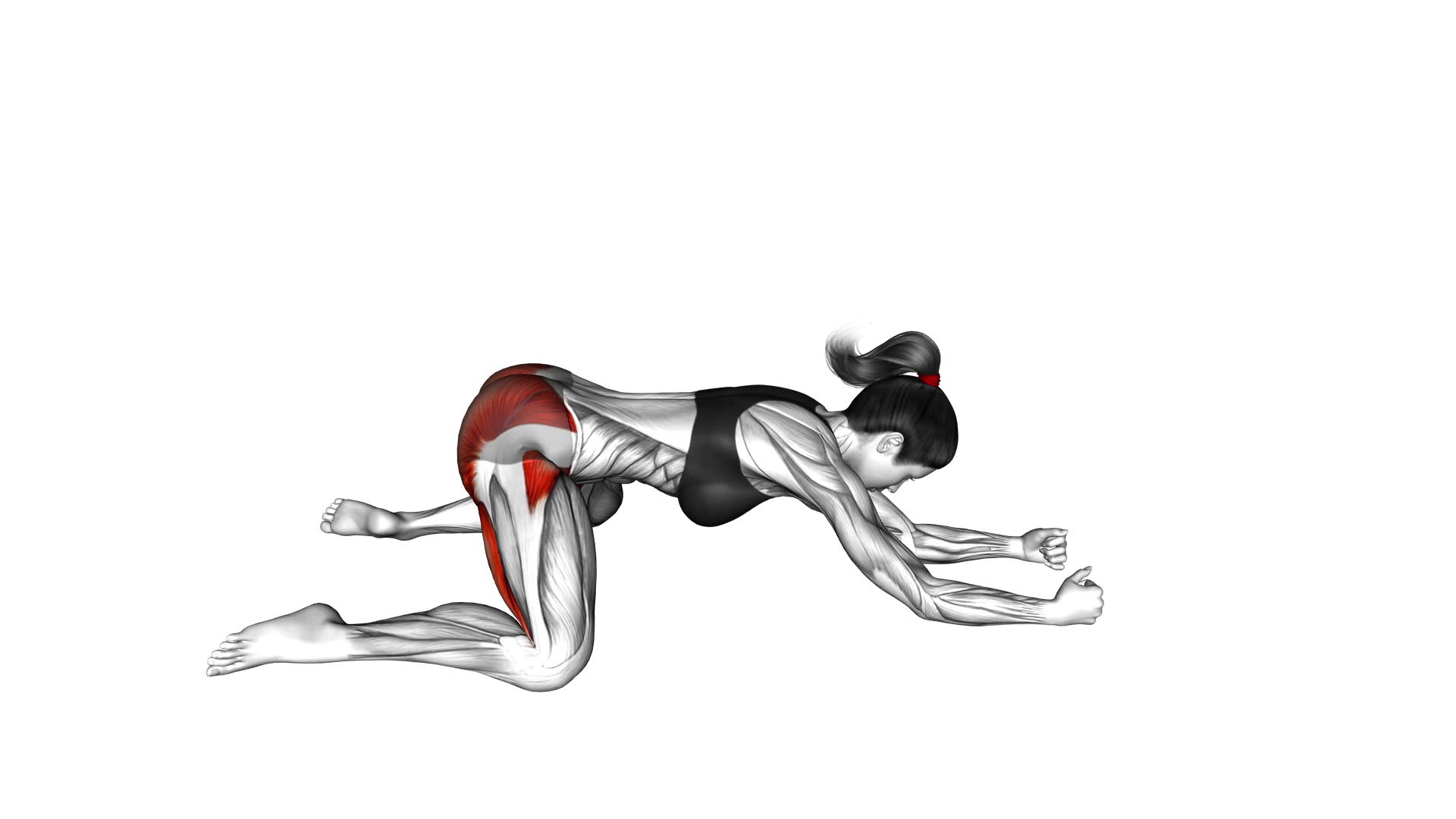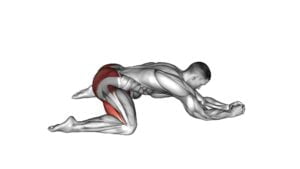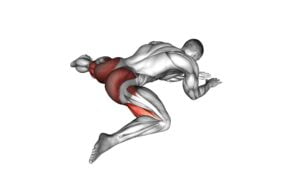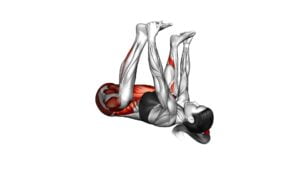Rocking Frog Stretch (female) – Video Exercise Guide & Tips

Get ready to stretch and strengthen your muscles with the rocking frog stretch! In this video exercise guide, we'll show you the proper form and technique for this effective stretch.
Watch This Exercise Video
Whether you're a beginner or have limited flexibility, we've got modifications to help you get the most out of this move.
Plus, we'll share tips on how to incorporate the rocking frog stretch into your workout routine.
Let's get started!
Key Takeaways
- The Rocking Frog Stretch improves flexibility and mobility in hips, thighs, and lower back.
- It promotes relaxation, relieves discomfort, and helps improve posture by addressing imbalances.
- The stretch targets hips, glutes, and inner thighs, enhancing lower body strength and preventing injuries.
- Proper form, breathing techniques, and gradual progression are important for maximizing the benefits of the stretch and avoiding mistakes or overexertion.
Benefits of the Rocking Frog Stretch
To experience the benefits of the Rocking Frog Stretch, position yourself on your hands and knees. This stretch is a great way to improve flexibility and mobility in your hips and lower back. By gently rocking back and forth, you can release tension and tightness in these areas, promoting relaxation and relieving any discomfort you may be feeling.
One of the key benefits of the Rocking Frog Stretch is that it can help improve your posture. By stretching the muscles in your lower back and hips, you can alleviate any imbalances that may be causing poor posture. Additionally, this stretch can also help to increase your range of motion, which is essential for performing daily activities and exercise with ease.
Furthermore, the Rocking Frog Stretch can be modified to suit your individual needs and abilities. If you find it challenging to maintain your balance or experience discomfort in your wrists, you can place a cushion or blanket under your hands for added support. You can also adjust the intensity of the stretch by rocking forward and backward at a pace that feels comfortable for you.
In the next section, we'll discuss the proper form and technique for performing the Rocking Frog Stretch to ensure you get the most out of this exercise.
Proper Form and Technique for the Exercise
To perform the Rocking Frog Stretch with proper form and technique, use a gentle rocking motion while on your hands and knees.
This exercise is excellent for improving mobility and increasing flexibility in your hips, thighs, and lower back.
Start by getting down on all fours, with your hands directly under your shoulders and your knees under your hips. Spread your knees apart, allowing your feet to come together behind you.
Keep your back straight and engage your core muscles. Gently rock your hips back and forth, moving your weight from your hands to your knees.
As you rock back, feel the stretch in your hips and thighs. As you rock forward, feel the stretch in your lower back.
Repeat this rocking motion for 10-15 repetitions, focusing on breathing deeply and relaxing into the stretch. Remember to listen to your body and only go as far as is comfortable for you.
With consistent practice, the Rocking Frog Stretch can help improve your mobility and increase your flexibility in the targeted areas.
Important Tips for Performing the Stretch
To ensure proper form and maximize the effectiveness of the rocking frog stretch, it's important to focus on your breathing techniques. Take deep breaths in and out as you move through the stretch, allowing your muscles to relax and release tension.
Additionally, be mindful of common mistakes such as overextending or forcing the stretch, as this can lead to injury. Keep the movements controlled and listen to your body's limits to avoid any unnecessary strain.
Breathing Techniques While Stretching
When performing the Rocking Frog Stretch (female), it's important to focus on your breathing technique. Proper breathing techniques can enhance muscle activation and help you achieve a deeper stretch. Here are some tips to keep in mind:
- Take slow, deep breaths in through your nose and exhale through your mouth.
- Breathe deeply into your diaphragm, allowing your belly to expand with each inhalation.
- Coordinate your breath with the movement of the stretch. Inhale as you prepare for the stretch and exhale as you deepen the stretch.
- Avoid holding your breath or breathing shallowly, as this can limit your range of motion and hinder the effectiveness of the stretch.
By incorporating these breathing techniques, you can optimize your stretching routine and improve flexibility.
Now let's move on to the next section and discuss some common mistakes to avoid.
Common Mistakes to Avoid
To ensure proper execution of the Rocking Frog Stretch (female) and avoid common mistakes, focus on maintaining proper form throughout the exercise. One common mistake to avoid is rounding your back. Keep your spine straight and engage your core muscles to prevent strain on your lower back.
Another mistake isn't properly warming up before attempting this stretch. It's important to prepare your muscles by doing light cardio or dynamic stretching beforehand.
Additionally, beginners may need modifications to make the stretch more accessible. If you find it difficult to reach your feet with your hands, try using a yoga strap or towel to assist you. Remember to listen to your body and only go as far as feels comfortable.
Modifications for Beginners or Those With Limited Flexibility
If you're a beginner or have limited flexibility, there are modifications you can make to the rocking frog stretch to make it more accessible.
Start with gentle stretches that focus on opening up the hips and gradually increase the intensity as you become more comfortable.
Flexibility exercises that target specific limitations, such as tight hip flexors or hamstrings, can also help improve your range of motion over time.
Gentle Stretches for Beginners
Start with gentle stretches to gradually increase flexibility and avoid straining your muscles. These stretches are perfect for beginners or those with limited flexibility. Here are some modifications you can make to accommodate your current level:
- Start with smaller movements: Instead of going for a full range of motion, begin with smaller movements that feel comfortable for your body. This will help prepare your muscles for more challenging stretches.
- Use props for support: If you find it difficult to maintain balance or hold a stretch, consider using props like blocks or straps to assist you. These props can provide stability and make the stretches more accessible.
- Focus on proper alignment: Pay attention to your body alignment during the stretches. It's important to maintain good posture and engage the right muscles to avoid unnecessary strain or injury.
- Listen to your body: Always listen to your body and respect its limits. If a stretch feels too intense or painful, back off and try a modified version or seek guidance from a professional.
Flexibility Exercises for Limitations
To gradually improve your flexibility and accommodate limitations, incorporate modifications into your flexibility exercises.
Flexibility challenges can arise from a variety of factors, such as age, injury, or simply being a beginner. Fortunately, there are stretching modifications that can help you work towards increased flexibility, even if you have limited range of motion.
One modification you can try is using props, such as a yoga block or a strap, to support your body and assist in the stretches. Another modification is adjusting the intensity or duration of the stretch to suit your current abilities.
Remember to listen to your body and only push yourself as far as is comfortable. With consistency and patience, you can gradually improve your flexibility and overcome your limitations.
How to Incorporate the Rocking Frog Stretch Into Your Workout Routine
Include the rocking frog stretch as the third exercise in your lower body workout routine. This stretch specifically targets your hips, glutes, and inner thighs, improving flexibility and mobility in those areas.
To incorporate the rocking frog stretch into your workout routine effectively, follow these steps:
- Start by lying on your back with your knees bent and feet flat on the floor.
- Place the soles of your feet together, allowing your knees to fall to the sides, creating a diamond shape with your legs.
- Gently push your knees towards the floor, feeling a stretch in your inner thighs.
- Hold the stretch for 30 seconds, breathing deeply and relaxing into the position.
- Repeat the stretch for 2-3 sets, gradually increasing the duration as your flexibility improves.
By including the rocking frog stretch in your workout routine, you can enhance your lower body strength and flexibility.
Remember to listen to your body and never push yourself beyond your limits. If you find it challenging to perform the stretch, you can modify it by using a yoga block or pillow under your knees for support.
Don't forget to explore different rocking frog stretch variations to target specific muscle groups and add variety to your routine.
Incorporating stretching into your workout routine is essential for injury prevention and overall muscle health.
Safety Precautions and Common Mistakes to Avoid
To ensure safe and effective execution of the rocking frog stretch, it's important to be aware of potential risks and mistakes to avoid. By following proper safety measures and taking precautionary steps, you can minimize the chances of injury and maximize the benefits of this exercise.
Firstly, it's crucial to warm up your muscles before attempting the rocking frog stretch. This helps to prevent strains and pulls. Start with a few minutes of light cardio exercises such as jogging in place or jumping jacks to increase blood flow to the muscles.
When performing the rocking frog stretch, avoid bouncing or jerking movements. Instead, focus on smooth and controlled motions. This will help to stretch the muscles without causing any unnecessary strain.
Another common mistake to avoid is overstretching. While it's important to challenge yourself, pushing too hard can lead to injury. Listen to your body and stop if you feel any sharp pain or discomfort.
Additionally, make sure to maintain proper form throughout the exercise. Keep your back straight and your core engaged. This will help to protect your spine and prevent any strain on your lower back.
Frequently Asked Questions
Can the Rocking Frog Stretch Help With Lower Back Pain?
Yes, the rocking frog stretch can help with lower back pain.
By gently rocking back and forth in this stretch, you can increase flexibility and mobility in your lower back muscles, which can alleviate pain and tension.
Additionally, this stretch helps to stretch and strengthen the core muscles, which can also support the lower back and prevent future pain.
Remember to modify the stretch if needed for your individual needs or injuries.
Is It Recommended to Hold the Stretch for a Specific Amount of Time?
When doing the rocking frog stretch, it's important to know if there's a recommended time to hold the stretch. Holding the stretch for a specific amount of time can help you get the most benefit from the exercise.
It's recommended to hold the stretch for about 20-30 seconds. This allows your muscles to stretch and relax properly. Remember to listen to your body and don't push yourself too hard.
Are There Any Alternative Stretches That Can Be Done for the Same Muscle Group?
If you're looking for alternative stretches for the same muscle group, there are a few options you can try.
One option is the modified frog stretch, which is similar to the rocking frog stretch but with some modifications to target the muscles in a different way.
Another option is the butterfly stretch, which also targets the inner thighs and hip muscles.
Both of these stretches can be effective in stretching and strengthening the same muscle group as the rocking frog stretch.
Can the Rocking Frog Stretch Be Done Before or After a Workout?
Before or after your workout, it's important to incorporate pre-workout and post-workout stretching into your routine.
Stretching before your workout helps to warm up your muscles, increase flexibility, and reduce the risk of injury.
On the other hand, stretching after your workout helps to cool down your muscles, improve flexibility, and aid in recovery.
The rocking frog stretch can be a beneficial stretch to include in both your pre-workout and post-workout stretching routines.
Are There Any Specific Breathing Techniques That Should Be Used During the Stretch?
During the Rocking Frog Stretch, it's important to focus on your breathing. Proper breathing techniques can enhance the benefits of this stretch.
Take slow, deep breaths as you move through the motion. Inhale deeply as you rock back, and exhale fully as you rock forward. This rhythmic breathing can help you relax and deepen the stretch.
Conclusion
Incorporating the rocking frog stretch into your workout routine can provide numerous benefits, including increased flexibility and improved lower body strength.
By following proper form and technique, you can maximize the effectiveness of this exercise.
Remember to listen to your body and make modifications if needed, especially if you're a beginner or have limited flexibility.
With safety precautions in mind, the rocking frog stretch can be a valuable addition to your fitness routine.

Author
Years ago, the spark of my life’s passion ignited in my mind the moment I stepped into the local gym for the first time. The inaugural bead of perspiration, the initial endeavor, the very first surge of endorphins, and a sense of pride that washed over me post-workout marked the beginning of my deep-seated interest in strength sports, fitness, and sports nutrition. This very curiosity blossomed rapidly into a profound fascination, propelling me to earn a Master’s degree in Physical Education from the Academy of Physical Education in Krakow, followed by a Sports Manager diploma from the Jagiellonian University. My journey of growth led me to gain more specialized qualifications, such as being a certified personal trainer with a focus on sports dietetics, a lifeguard, and an instructor for wellness and corrective gymnastics. Theoretical knowledge paired seamlessly with practical experience, reinforcing my belief that the transformation of individuals under my guidance was also a reflection of my personal growth. This belief holds true even today. Each day, I strive to push the boundaries and explore new realms. These realms gently elevate me to greater heights. The unique combination of passion for my field and the continuous quest for growth fuels my drive to break new ground.







